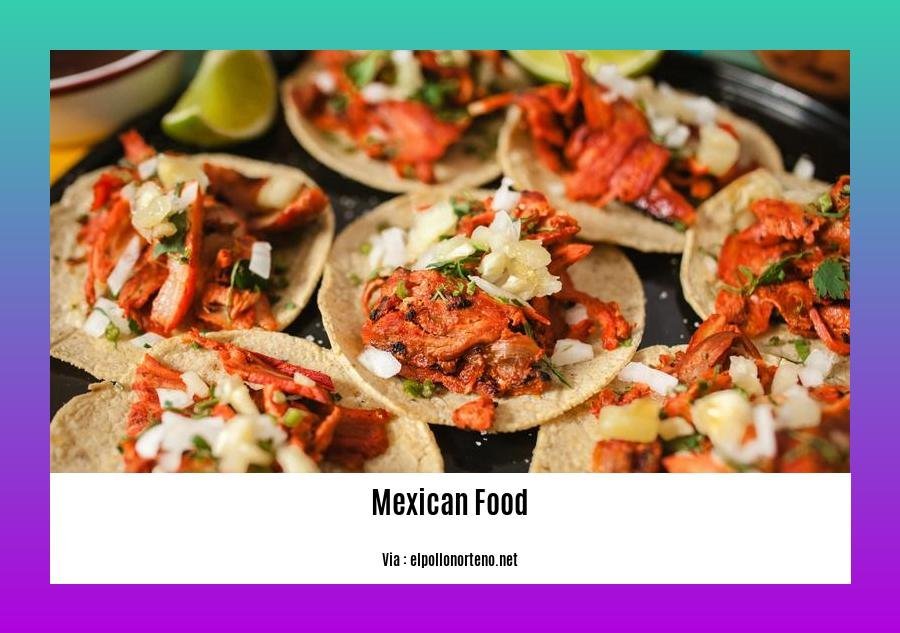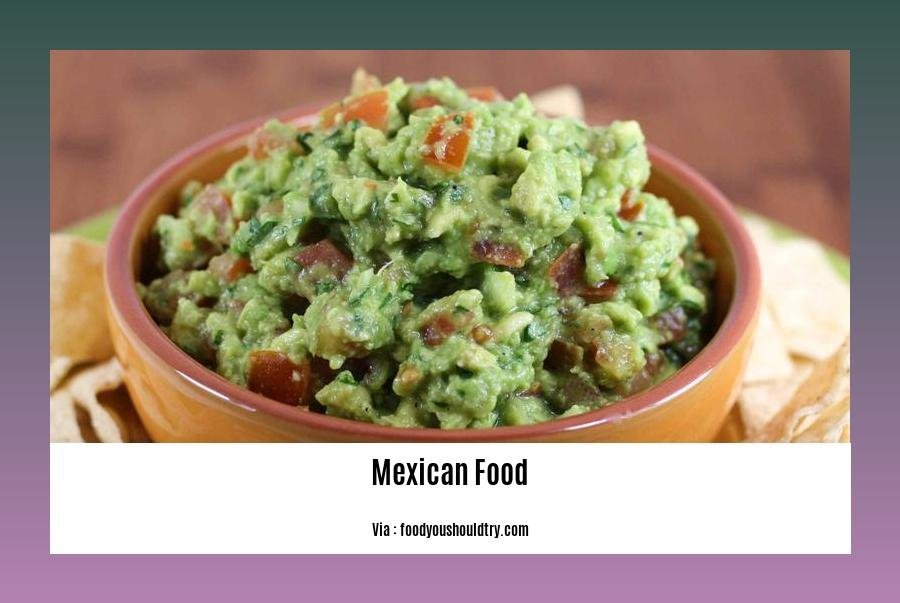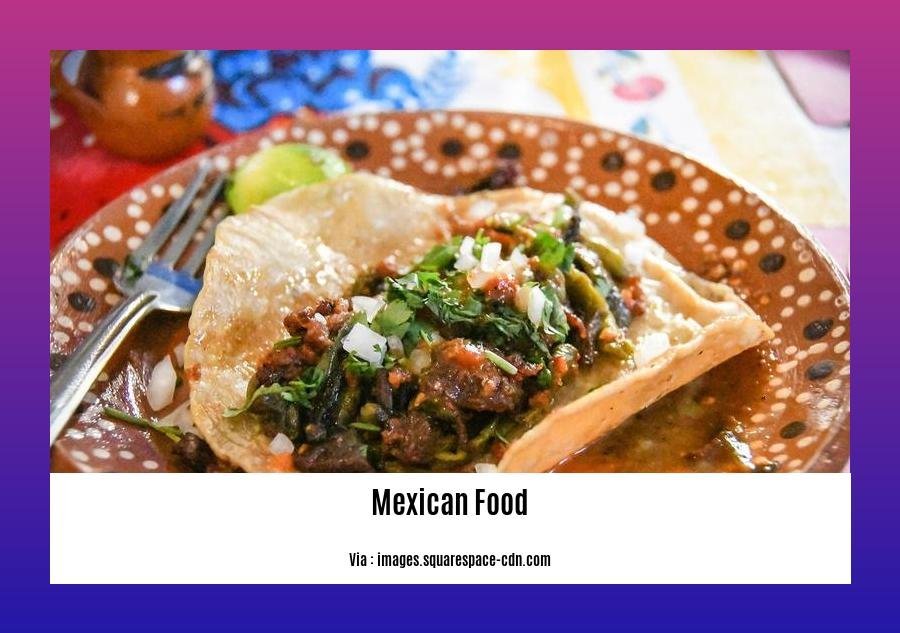Embark on a delectable journey through the vibrant world of Mexican cuisine as we delve into 10 fascinating facts about Mexican food. From the rich flavors that dance on your taste buds to the captivating history that shaped this culinary heritage, prepare to unravel the secrets behind some of the most beloved dishes. Discover the regional diversity that adds a kaleidoscope of flavors to Mexico’s gastronomic tapestry and the cultural significance that elevates each ingredient and technique. Get ready to be captivated by the tantalizing stories that lie within the savory and spicy delights of Mexican food.
Key Takeaways:
- Mexican cuisine offers a wide variety of flavors, not all of which are spicy.
- The Northern region of Mexico is known for its meat dishes, while the Southern region tends to focus more on chicken and vegetables.
- Traditional Mexican dishes can include ingredients like rattlesnake, spider monkey, and iguana.
- Mexican cuisine incorporates a lot of vegetables, making it a healthy choice.
- Several popular ingredients, including tomatoes, chia, vanilla, and dragonfruit, originated in Mexico.
- Before the arrival of the conquistadors, Mexican cuisine was primarily based on healthy, plant-based foods.
- Spanish cuisine had a significant influence on the development of Mexican dishes.
- Mexican food often incorporates a generous amount of vegetables and fruits.
- The Caesar salad actually originated in Mexico.
- Mexican cuisine has been shaped by various immigrant communities.
- Staple ingredients in Mexican dishes include maize, different kinds of beans, chili peppers, and fruit.
- Mexico’s history of Spanish colonization has had a lasting impact on its culinary traditions.
Facts About Mexican Food: Unraveling the Flavors and History

Mexican cuisine is a vibrant and diverse culinary tradition that offers an array of flavors and unique dishes. Let’s explore some fascinating facts about Mexican food that will ignite your curiosity and deepen your appreciation for this rich gastronomic heritage.
1. Not All Mexican Food Is Spicy
Contrary to popular belief, not all Mexican food is spicy. While chili peppers are a staple ingredient in many Mexican dishes, the level of spiciness can vary greatly. From mild to fiery, there is something for every palate in Mexican cuisine. So, don’t shy away from trying Mexican flavors based on assumptions about spice!
2. Regional Diversity in Mexican Cuisine
Mexican cuisine showcases regional diversity, with distinct culinary traditions in different parts of the country. In the northern regions of Mexico, meat dishes like carne asada and machaca are popular, while in the southern areas, chicken and vegetable-based dishes take the spotlight. This regional variation adds depth and variety to Mexican culinary experiences.
3. Exotic Ingredients in Traditional Mexican Dishes
Traditional Mexican dishes often feature unique and exotic ingredients. In the past, dishes may have even included ingredients like rattlesnake, spider monkey, or iguana. Today, while these may be less common, Mexican cuisine still incorporates myriad ingredients, including a wide variety of vegetables, herbs, and spices.
4. Ancient Origins of Mexican Vegetables
Mexico has given birth to several vegetables that are now enjoyed worldwide. For instance, tomatoes, chia seeds, vanilla, and dragon fruit originated in Mexico. These ingredients showcase the rich biodiversity and agricultural expertise of ancient Mexican civilizations.
5. The Healthy Roots of Mexican Cuisine
Before the arrival of the Spanish conquistadors, Mexican cuisine was predominantly plant-based and healthy. The indigenous communities relied on a wide range of vegetables, fruits, and herbs in their diets. The introduction of meat by the Spanish influences changed the landscape of Mexican cuisine, adding new flavors and culinary possibilities.
6. Spanish Influence on Mexican Cuisine
During the Spanish colonization of Mexico, Spanish cuisine heavily influenced Mexican culinary traditions. Ingredients like wheat, rice, and various spices were introduced, as well as cooking techniques such as frying. This fusion of Spanish and indigenous Mexican cuisines created a distinct and vibrant culinary heritage that we know today as Mexican cuisine.
7. Abundance of Vegetables and Fruits
Mexican food is renowned for its colorful and vibrant use of vegetables and fruits. From flavorful salsas made with roasted tomatoes and chilis to refreshing fruit salads sprinkled with chili powder, Mexican cuisine expertly incorporates a wide range of fresh produce. The abundance of these healthy and nutritious ingredients contributes to the holistic approach of Mexican cooking.
8. Surprising Origins of Caesar Salad
Did you know that Caesar salad, a beloved classic in Western cuisine, was actually invented in Mexico? The salad was created by an Italian immigrant, Caesar Cardini, who was operating a restaurant in Tijuana during the Prohibition era. Cardini improvised and concocted a refreshing salad using the ingredients he had on hand. This iconic dish continues to be enjoyed worldwide.
9. Influence of Immigrants on Mexican Food
Mexican cuisine has been enriched by the influence of immigrants from various parts of the world. For example, Lebanese immigrants brought their expertise in baking bread and introduced dishes like tacos al pastor, which combines the flavors of Middle Eastern shawarma with Mexican ingredients. The fusion and innovation resulting from these cultural exchanges contribute to the vibrant tapestry of Mexican culinary traditions.
10. Key Ingredients in Mexican Cuisine
Mexican cuisine relies on a few key ingredients that form the foundation of many dishes. These include maize (corn), various kinds of beans, chili peppers in all their glorious varieties, and an assortment of fruits. These ingredients are used in a myriad of creative ways, providing depth, flavor, and a touch of heat to Mexican dishes.
Mexican food is a treasure trove of flavors, history, and cultural significance. By unraveling these fascinating facts about Mexican cuisine, we can gain a deeper appreciation for its diversity and complexity. So, let’s celebrate the vibrant world of Mexican gastronomy and continue to explore the rich heritage it has to offer.
Here are some interesting facts about Indian weddings that you probably didn’t know! Did you know that Indian weddings are known for their vibrant and colorful attire? Explore more fascinating facts about Indian weddings here.
Discover the fascinating world below the water’s surface with these intriguing facts about life below water. Dive into a sea of knowledge and uncover hidden wonders by clicking here.
Are you a Liverpool football team fan? If so, you won’t want to miss out on these captivating facts about the Liverpool football team. Click here to uncover interesting trivia about your favorite team.
Sign language is a beautiful and expressive form of communication. Delve into the world of sign language and learn some amazing facts by clicking here.
Mexican Food: Exploring the Rich Variety of Mexico’s Dishes

Mexican food has gained global popularity for its unique and appealing flavors, which can be attributed to the authentic Mexican cuisine that blends ancient traditions with modern influences. The use of traditional ingredients and spices is what sets Mexican food apart and contributes to its bold and complex flavors.
One of the most iconic dishes in Mexican cuisine is chili con carne, a spicy stew made with chili peppers, ground beef, and a variety of spices such as cumin, paprika, and garlic. These ingredients come together to create the distinctive and irresistible flavors that make Mexican food so flavorful and aromatic.
While many people associate Mexican gastronomy with tacos, burritos, and nachos, there is much more to discover in regional Mexican cuisine. Each region in Mexico has its own unique dishes and flavor profiles, showcasing the diverse culinary heritage of the country. Exploring regional variations of Mexican cuisine allows for a deeper understanding, and appreciation of the rich culinary traditions that exist across Mexico.
If you’re looking to experience the authentic tastes of Mexico, there are some popular dishes that you must try. These include dishes like enchiladas, tamales, mole, and pozole. Each dish offers its own distinct flavors and ingredients, showcasing the variety and depth of Mexican cuisine.
Mexican Food’s Spices and Flavors
What truly makes Mexican food so flavorful and aromatic is the use of traditional ingredients and spices. In addition to chili peppers, common spices used in Mexican cuisine include cumin, oregano, cinnamon, garlic powder, onion powder, paprika, pepper, thyme leaves, and coriander. These spices add depth and complexity to Mexican dishes, creating a sensory experience that is truly unique.
Mexican cuisine expertly incorporates a wide variety of spices and flavors, resulting in dishes that are vibrant and full of character. From the heat and earthiness of chili peppers to the warmth and depth of cumin and oregano, each spice has its own distinct flavor profile that contributes to the overall taste of Mexican food.
The combination of these spices with other ingredients like tomatoes, onions, and various meats creates a harmonious balance of flavors that is both satisfying and delicious. Whether it’s the smoky spiciness of a chili con carne or the aromatic sweetness of a traditional mole sauce, Mexican food offers a culinary adventure for your taste buds.
Key Takeaways:
- Mexican food incorporates a wide variety of spices and flavors, including chili peppers, cumin, oregano, and garlic.
- Traditional Mexican dishes, such as chili con carne, showcase the unique and irresistible flavors created by the use of these spices.
- Regional variations of Mexican cuisine highlight the diverse culinary heritage of Mexico.
- Popular Mexican dishes like enchiladas, tamales, mole, and pozole offer their own distinct flavors and ingredients.
- The combination of spices like chili peppers, cumin, and oregano adds depth and complexity to Mexican dishes, creating a sensory experience that is truly unique.
Sources:
– rrealtacos.com
– tacoandpina.com
Modern Mexican Cuisine: A Fusion of Indigenous Traditions and Spanish Colonization
Mexican cuisine is a journey through history, with its modern iteration heavily influenced by indigenous traditions and Spanish colonization. This fusion of cultures and flavors has resulted in a vibrant and diverse culinary heritage that continues to captivate and delight food enthusiasts around the world.
A Blend of Traditions
Modern Mexican cuisine is a product of the rich history and cultural diversity of Mexico. The indigenous populations, such as the Mayans and Aztecs, played a significant role in shaping traditional Mexican dishes. Corn, a staple in Mayan cuisine, remains a fundamental ingredient in Mexican cooking today. Indigenous crops like chili peppers, black beans, tomatoes, squash, and corn form the bedrock of many Mexican dishes, providing a distinct flavor profile that sets Mexican cuisine apart.
Spanish Culinary Influence
The arrival of the Spanish conquerors in the 16th century brought about a significant shift in Mexican cuisine. The Spanish colonizers introduced new ingredients and cooking techniques, forever altering the culinary landscape. Spanish influence can be observed in the inclusion of ingredients like wheat, rice, and various spices, which were previously unknown in the indigenous Mexican diet. The fusion of indigenous and Spanish traditions gave rise to the distinctive flavors and techniques that define modern Mexican cuisine.
An Explosion of Flavors and Ingredients
Modern Mexican cuisine is marked by its bold flavors, vibrant colors, and diverse ingredients. From tangy salsas to smoky moles, each dish tells a story of Mexico’s culinary heritage. The use of spices like chili peppers, cumin, oregano, and garlic adds depth and complexity to Mexican dishes, creating a symphony of flavors that tantalize the taste buds. Whether it’s the savory richness of tamales or the refreshing crunch of a taco, Mexican cuisine offers a vast array of tastes and textures.
Regional Diversity in Mexican Cuisine
One cannot explore Mexican cuisine without acknowledging its regional diversity. Each region in Mexico boasts its own unique culinary traditions, showcasing the vast array of flavors and ingredients found throughout the country. From the seafood-focused cuisine of Baja California to the rich mole sauces of Oaxaca, each region offers a distinct gastronomic experience. Exploring these regional variations allows one to delve deeper into the culinary tapestry that is Mexican cuisine.
Cultural Significance and Recognition
Mexican cuisine holds immense cultural significance and has been recognized as an Intangible Cultural Heritage of Humanity by UNESCO. This designation highlights the importance of Mexican food as a cultural expression that has been passed down through generations. Mexican cuisine is not only about the food itself but also the traditions, rituals, and communal aspects that surround it. It is a celebration of Mexico’s rich history and its people’s deep connection with the land and its bounty.
Key Takeaways:
– Modern Mexican cuisine has been shaped by a fusion of indigenous traditions and Spanish colonization.
– Indigenous crops like corn, chili peppers, and beans form the foundation of Mexican cuisine.
– Spanish culinary influence introduced new ingredients and cooking techniques to Mexican cuisine.
– Mexican cuisine is known for its bold flavors, vibrant colors, and diverse ingredients.
– Regional diversity plays a significant role in Mexican cuisine, with each region offering its own unique dishes and flavors.
– Mexican cuisine has been recognized as an Intangible Cultural Heritage of Humanity by UNESCO.
Sources:
– Exploring Latinx Food + Cuisine | The Journal by B/SPOKE
– The Rich History of Mexico’s Cuisine | A Culinary Journey
Mexican Street Food: Exploring the Heart of Mexican Culinary Culture
Mexican street food is an integral part of the culinary culture, offering a wide range of delicious and affordable options. From the bustling streets of Mexico City to the small towns and villages across the country, Mexican street food is a vibrant and essential element of daily life. It reflects the rich history, regional diversity, and cultural significance that make Mexican cuisine so fascinating. So, let’s dive into the world of Mexican street food and unravel its tantalizing flavors and stories.
The Delights of Antojitos: A Taste of Mexico Everywhere
Mexican street food is renowned for its antojitos, which are inexpensive and bite-sized snacks that can be found throughout the country. These savory treats come in a multitude of flavors and textures, enticing both locals and adventurous travelers. Imagine savoring the crispy delight of a sopes or the satisfying bite of a quesadilla, bursting with gooey cheese and flavorful fillings. These antojitos truly capture the essence of Mexican street food: affordable, quick, and irresistibly delicious.
Taco: The Icon of Mexican Street Food
No exploration of Mexican street food would be complete without mentioning the iconic taco. A thin, griddle-baked tortilla topped with a myriad of fillings and enjoyed without utensils, tacos are a beloved street food staple in Mexico. Whether filled with succulent meats, fresh seafood, or hearty veggies, tacos are a culinary adventure in every bite. The combination of vibrant flavors, aromatic spices, and the simplicity of this handheld delight is what makes tacos an enduring favorite among locals and tourists alike.
Regional Gems: Guadalajara’s Pambazos and Torta Ahogada
Venture further into the diverse realm of Mexican street food, and you’ll discover regional gems like Guadalajara’s pambazos and torta ahogada. Pambazos are made with bread that lacks a crusty shell, which is then filled with various mouthwatering ingredients such as chorizo, potatoes, and cheese. Meanwhile, the torta ahogada is a sandwich filled with meat and served drowned in a spicy sauce. These dishes showcase the creativity and unique blend of flavors that define Mexican street food, even within specific regions of the country.
The Cultural Significance of Mexican Street Food
Mexican street food goes beyond its delectable flavors; it holds a deep cultural significance as well. The act of cooking and eating street food on bustling streets and lively markets has always been an integral part of Mexican life. It brings people together, transcending social barriers, and fostering a sense of community. Mexican street food is not just about the food itself; it’s about the shared experiences and the connection to Mexico’s vibrant culinary traditions.
Key Takeaways:
– Mexican street food offers a wide variety of affordable and flavorful options that are integral to Mexican culinary culture.
– Antojitos, bite-sized snacks, embody the essence of Mexican street food, with their affordable prices and mouthwatering flavors.
– Tacos, a beloved icon of Mexican street food, showcase the simplicity and versatility that make them a street food favorite.
– Regional specialties like pambazos and torta ahogada highlight the regional diversity and unique flavors found in Mexican street food.
– Mexican street food holds a significant place in Mexican culture, fostering a sense of community and connection.
Sources:
1. Mexican Travel Blog. “Mexican Antojitos: 25 Mexican Street Food to Try.” Link
2. TasteAtlas. “53 Best Street Foods in Mexico.” Link
FAQ
Q1: Is all Mexican food spicy?
A1: No, Mexican cuisine is not all spicy. While chili peppers are commonly used in Mexican dishes, there are many dishes that are not spicy at all. Mexican cuisine offers a wide range of flavors, from mild to very spicy, catering to different preferences.
Q2: What are some popular ingredients in Mexican cuisine?
A2: Mexican cuisine incorporates a variety of ingredients. Some popular ingredients include maize (corn), different kinds of beans, chili peppers, tomatoes, chia seeds, vanilla, dragonfruit, as well as various fruits and vegetables. These ingredients contribute to the diverse flavors and vibrant colors of Mexican dishes.
Q3: How has Mexican cuisine been influenced by other cultures?
A3: Mexican cuisine has been influenced by several cultures throughout its history. The cuisine was influenced by the Mayans, Aztecs, and Spaniards, resulting in unique flavors and cooking techniques. Additionally, Mexican cuisine has also been influenced by immigrants from various countries, contributing to the fusion of different culinary traditions.
Q4: What are some traditional Mexican dishes?
A4: Traditional Mexican dishes include enchiladas, tamales, mole, pozole, and chiles rellenos. Each dish has its own distinct flavors and ingredients, showcasing the rich culinary heritage of Mexico. These traditional dishes often incorporate a combination of spices, herbs, and regional ingredients.
Q5: How did Spanish influence impact Mexican cuisine?
A5: Mexican cuisine was significantly influenced by Spanish cuisine during the period of Spanish colonization. The introduction of ingredients such as rice, wheat, and various spices greatly influenced the development of Mexican cuisine. Spanish cooking techniques and ingredients were assimilated into traditional Mexican dishes, resulting in a unique blend of flavors and culinary traditions.
















